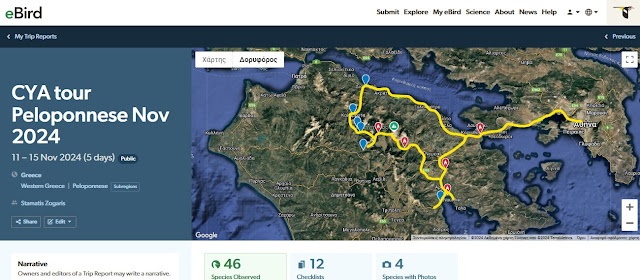November 2024
Kokartza Kilkis, Northern Greece
Kokartza Kilkis is a tiny hamlet of 30 souls in the middle of the Kilkis steppe in Central Macedonia, not far from Thessaloniki. This could be a rather famous place for Greek ichthyology. It was here that the late Professor P.S. Economidis discovered one of two Northern Greek populations of a fish similar to the Southern Nine-Spine Stickleback (Pungitius aff. platygaster). In fact there are two Pungitius stickleback taxons in Greece, the southern population, at the Spercheios valley which was initially named Pungitius hellenicus (published by Stephanidis in 1971), and the northern population (at Aravissos- in the Loudias system and Kokartza- in the Axios/Vardar valley). Yes the northern ones are considered similar to the other European/Ponto-Caspian ones, loosely named Pungitius platygaster.
However there is a important note: Both sticklebacks (the northern Greek and Spercheios populations) are genetically more closely related to each other then the Southern Nine-back Sticklebacks, the "true" Pungitius platygaster!
The map above from an old Sovient publication shows the wide range of the Pungitius platygaster populations (related to the more widespread Pungitius pungitius) and I have incerted (in red) two areas of the Greek populations Pungitius. These two dots are the Pungitius aff. platygaster in Northern Greece (Aravissos and Kokartza) and Pungitius hellenicus in the Spercheios Valey near Lamia in Central Eastern Greece.
Thanks to research being done by Alcibiades Economou and colleagues, we are still trying to figure out the biogeography, genetic relationships and species status of these tiny fishes. Although the two populations have diverged from other Pungitius they are also quite distinct units. Perhaps even to the species level, i.e. two species, distinct from Pungitius platygaster, both originating from it. In this posting I am refering to our northern Greek fish as Pungitius aff. platygaster for the first time. (The tiny word "aff" or Species affinis" is a term used in biological taxonomy to mean that a proposed species is closely related to, but not the same as, the species listed after it. The Latin word "affinis" translates to "closely related to" or "akin to). With the recent genetic analyses available, perhaps we could call the northern populations Pungitius aff. hellenicus or it may be described as a new species in the future!
Anyway, the Northern Greek Sticklebacks are still being officially called Southern Nine-Spines, Pungitius platygaster, pending a thorough review and wider genetic analysis. And we are assessing their conservation status based on their distribution within Greece (I did the IUCN Greek Red List review recently). Note that the other Northern Greek Pungitius population is restricted to Aravissos springs, part of the Loudias-Lake Gianitsa system, neighbouring to the west of the Axios valley. It would be great if we could get some genetic material from Kokartza.
So the question is: do they still exist in Kokartza?
We needed to go to Kokartza village! Where we too late? (...2024 was an exceptional drought year). Maybe we overlooked the issue and we may not have persisted in asking Economidis about this earlier. If I recall correctly, P.S. Economidis had told Alcibiades Economou and I that he had searched elsewhere in the Axios Valley and found it nowhere. However, in the 2008 Greek Red Data book account he gives the impression that it was extant at Kokartza; he gives Kokartza as a 'point on the map' (Economidis and Chrysopolitou 2008).
Of course using Google Earth you can easily find both the Kokartza hamlet and its tiny reedswamp wetland where the spring's 'well' located (right next to the pump house). We decided to visit late this November.
The Landscape
The 'Well'
Professor Economidis talks about a 'filthy well' when refering to Kokartza - the only place the species exists in the wetland of Kokratza. During our visit we found no drop of water in the sourrounding tiny Phragmites reedswamp and two rather modern-looking well-like structures; one deeper - the round one and one very shallow, a rectangular cistern. Locals said that long ago this was a cold water spring and was known as a drinking-water source. There is a pump-house next to the well.
We used a long dip-net to try to see if there was any life in the two well-like structures. In the very shallow rectangular cistern we found nothing but a toad (Bufo bufo). No invertebrates in the water. The concrete block hatch on top had toppled down and light was now penetrating into the shallow cistern. But there was no aquatic vegetaion. An animal (mammal) was scurring inside, but we did not find it. We rescued the toad.
Dedication
I dedicate this post to the remarkable man behind the name of P.S. Economidis (1934-2021). One of the most interesting men I have ever met and a remarkable natural historian. I knew him very little, but on and off called on him during a period of about 20 years. We went on a few trips together (Evia, Rhodes, Northern Greece, etc). We liked each other, but he was a 'difficult' man and many people would be cruel to him, or maybe they would misinerpret him. I guess he was mad at the world. He was protective of his data. Many colleagues were probably envious of his strong mind and incredible memory and the deptsh of his natural history knowledge. I kept notes on nearly all my discussions with him. He was also a philosopher and a Patriot; a kind of wonderful Zorba The Greek of the Icthyological world. May he Rest in Peace.
References
Economidis, P. S. "Endangered freshwater fishes of Greece." Biological Conservation 72, no. 2 (1995): 201-211.Economidis, P.S. & V.P. Voyadjis. (1985). Les poissons des systèmes d'Axios-Doirani et de Gallikos (Macédoine, Grèce). Biologia Gallo-Hellenica, 10: 89-93.
Wang, Y., Wang, Y., Zhao, Y., Kravchenko, A.Y., Merilä, J. and Guo, B., (2022). Phylogenomics of northeast Asian Pungitius sticklebacks. Diversity and Distributions, 28(12), pp.2610-2621.

%205f%20Pungitius%20platygaster%20aralensis.jpg)


























